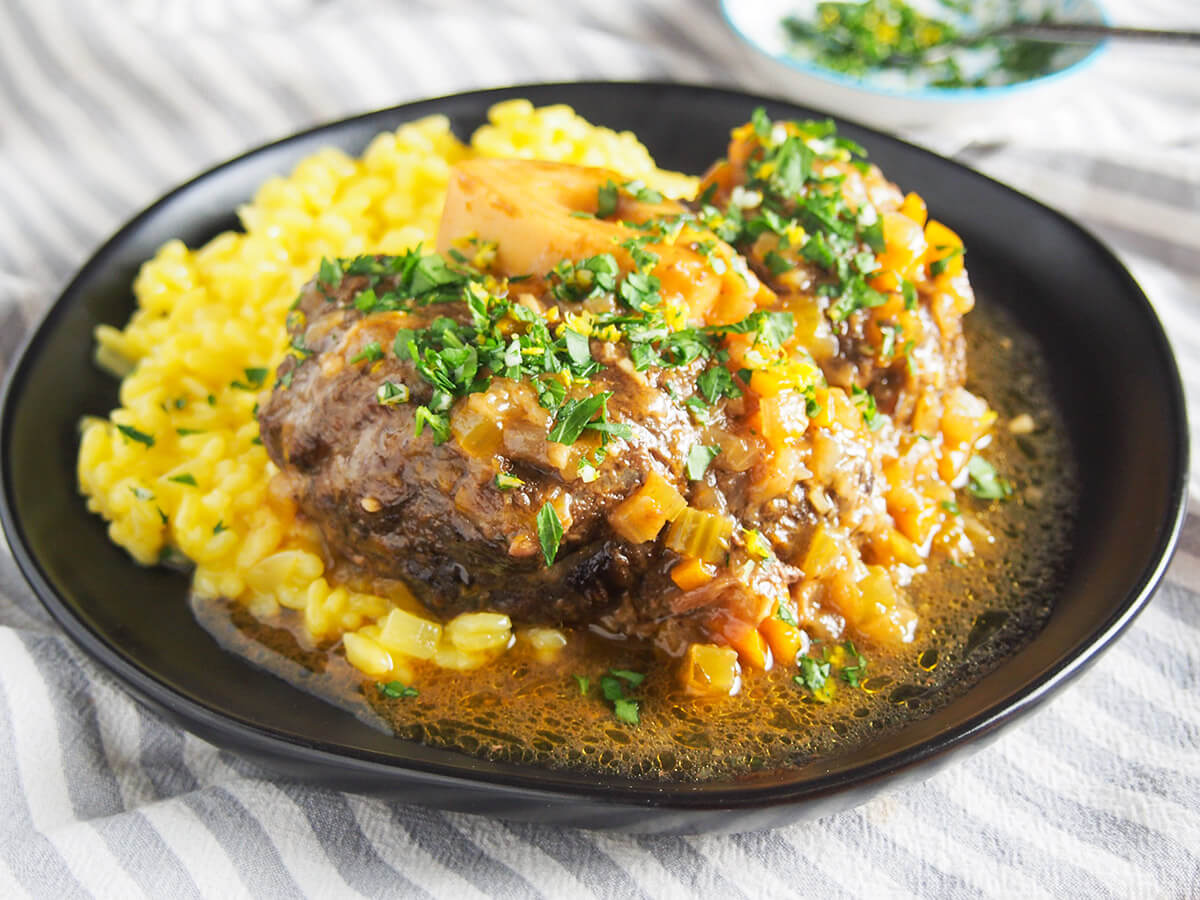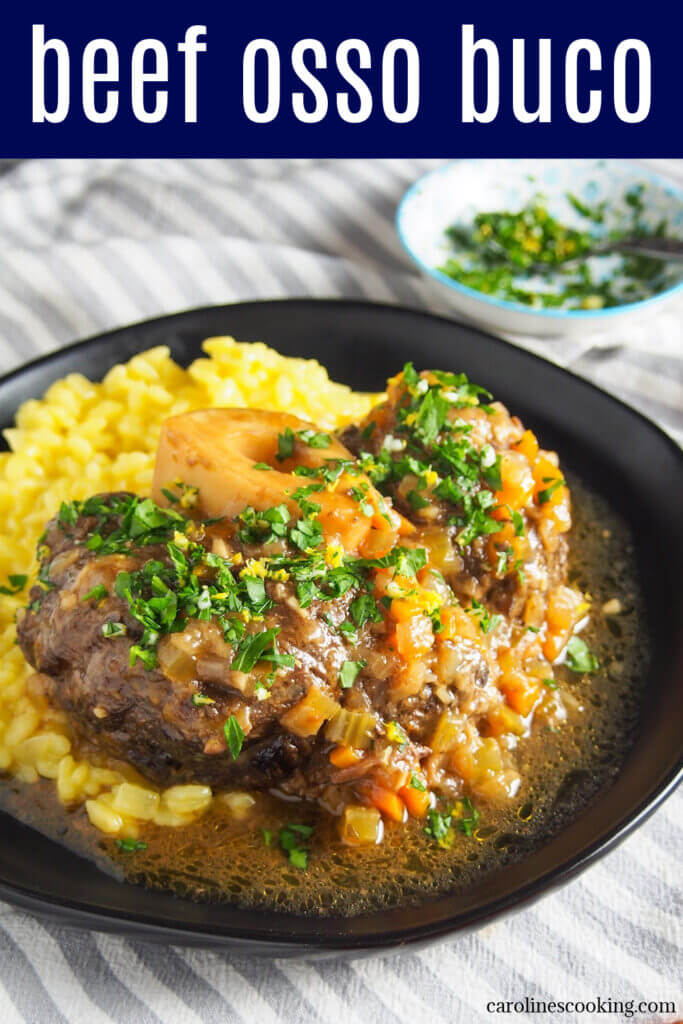Osso buco is a traditional slow cooked Italian dish. You traditionally use veal shank but this beef osso buco is made in the same way with a cut you may find more easily (and cheaper). It has the same delicious meltingly tender meat and bright gremolata finish. Perfect comfort food.

This post may contain affiliate links, where we earn from qualifying purchases. See more details in the policy page.
One thing I love about the weather getting colder is comfort food. Maybe it's partly because I grew up somewhere with generally rubbish weather, or maybe it's just a preference, but I somehow feel I have more go-to recipes for cold weather than warm. Soups, braises and roasts are definitely my game.
This is one that has been on my list to make for ever but has only entered our rotation more recently. In many ways, it's not so different from the likes of braised lamb shanks or any other braised meat, but there is a key difference: gremolata, which I'll explain a bit more below.

Where is osso buco from?
This dish (sometimes written as osso bucco) is originally from Northern Italy. Some would say it's from the Milan area in Lombardy, others say nextdoor Piedmont, but either way it's that general North-east region where it gets chilly in winter and this fits in perfectly.
"Osso bucco" is Italian for "bone with a hole" which is the core of this dish. It's traditionally made with slices of veal shank cut right through the bone, so the marrow ends up flavoring the braising liquid as well.
I for one have been finding veal less easy to find recently, and so I decided to make this with beef shank instead. While it's less traditional, it is just as delicious. The flavors are just a little less delicate, but it does give some scope to make a couple twists, too.

Cooking tips
The technique for cooking this is very similar to other braised dishes, with a few key steps:
- Dry then season and lightly dust the shanks with flour. All of this helps to ensure it will sear well and gives a little base of flavor. The flour also helps thicken the sauce, slightly, and soak up excess fat.
- Brown the shanks over a high heat and I recommend using a cast iron or other heavy pot. Don't overcrowd the pot/pan and leave the meat to get a good sear before turning. A good, brown sear = flavor. While here I only used two shanks, if you are cooking more, sear in batches to avoid overcrowding.
- Take your time softening the vegetables (using the same pot/pan). Onions take a good few minutes to really soften and bring out their natural sweetness, and the other vegetables similarly need some time.
- If you like, you can tie the shanks with kitchen twine around the middle to hold them together. However I for one don't really mind if they fall apart during cooking a bit.
- Reduce the wine down well then add stock and herbs. Bring this to a simmer then add back the shanks and let them cook low and slow. If your dish is wider, you may need to turn the meat part way through cooking so all of the meat stay moist and tender.

Adaptation options
Since this version has beef shank, you don't need to worry quite as much about other flavors overpowering the meat. So, for example, you could easily switch the traditional white wine for red wine, if you prefer.
Also, with veal you are best to use a light stock like chicken, or even just water, but with the beef you could also use beef stock if that is what you have.
One thing you can't change up, however, is time. Make sure you give the meat plenty of time to cook as shank is a cut that needs time to break down the connective tissue. That's even more the case with beef.
In fact, some would argue this is a dish that's better the next day. If nothing else, you can prepare it ahead of time either the day before or earlier in the day and re-heat when you are ready to serve.

The slow cook leaves you with meltingly tender meat and given the cut, you also get to enjoy the marrow from the middle of the bones, too.
How to serve this dish
First, you can't forget the gremolata on top of this as it's really a core part of the dish. The topping of parsley, lemon zest and garlic might seem an unusual combination and not a whole lot, but it really does add that something special.
The freshness of the parsley and lemon in particular really cuts through the richness of the meat. It works perfectly to both lift the flavors and make it that bit easier to eat.

Secondly, the classic accompaniment to this dish is risotto alla Milanese, which is essentially a variation on saffron risotto with bone marrow in it. Whether you go completely traditional, or make my saffron risotto, both are a wonderful pairing with this.
If you are not quite up for making risotto, some mashed potato, polenta or small pasta like orzo would also work well. Having something that can soak some of the delicious braising sauce is definitely worthwhile.
While it may not be completely traditional, I also like to have some green veg of some kind with this to balance out all the richness. Green beans are a favorite, but you could also have some sautéed spinach or chard.

Beef osso buco is a slightly richer version of the veal original, but with all the best qualities. The meat becomes meltingly tender, the wine-based sauce is packed with flavor. The gremolata on top adds that vibrant burst of freshness, just as it does color, to complete this wonderfully comforting meal.
Try these other comforting beef dishes:
- Short rib beef udon
- German beef rouladen (beef rolls with bacon pickle filling)
- Beef bourguignon
- Plus get more mains recipes and Italian recipes in the archives.
I make this in my 30cm/3.5 quart cast iron braiser which works well (affiliate link).
Beef osso buco
Ingredients
For beef
- 2 lb beef shank cut across the bone, approx 1 ¼in/3cm thick
- ¼ teaspoon salt
- ¼ teaspoon pepper
- 2 tablespoon flour approx
- 1 onion medium/small
- 1 carrot medium/small
- 1 rib celery
- 1 clove garlic
- 1 tablespoon olive oil (approx, for cooking - may need a little more)
- ¾ cup white wine
- 1 tablespoon tomato paste tomato puree
- 2 cups chicken stock
- 1 sprig thyme
- 1 bay leaf
For gremolata
- 1 ½ tablespoon chopped parsley
- ½ clove garlic
- ½ lemon zest ie zest from ½ lemon
Instructions
- Pat dry the beef shanks with kitchen paper then sprinkle salt and pepper on both sides of them. Dust both sides of the shanks with flour so that they are evenly but lightly covered then shake off any excess.
- Prepare the vegetables by dicing the onion, carrot and celery into a relatively fine dice. Finely dice the garlic.
- Warm the oil over a medium-high heat in a dish wide enough to hold the shanks in a single layer but ideally not too much larger - I used a cast iron braiser.
- Once the oil is hot, add the shanks and sear on both sides. Make sure you don't turn them too quickly - you want to get a good level of browning on both sides. Turn to sear slightly on the edges as well.
- Once seared all over, remove the shanks from the skillet. If you prefer, you can then tie kitchen twine around them to hold them together better during the rest of the cook but it is not needed if you don't mind that the shanks may break up slightly.
- Reduce the heat slightly and add the onion, carrot and celery. Add a little extra oil if needed. Cook, stirring now and then, for around 5 minutes to soften them. Once the onion is going translucent, add the garlic and continue to cook for a couple more minutes.
- Add the wine and bring to a simmer. Scrape the bottom of the pot to remove any browning (it adds flavor to the dish) as it simmers a couple minutes.
- Allow the wine to reduce by around half or more - it will become almost syrup-like - then add the tomato paste, stock, thyme sprig and bay leaf. Stir to mix them well and break up the tomato paste, bring back to a simmer then return the shanks to the pot.
- Cover the pot and reduce the heat to low so that the liquid continues to simmer but relatively gently. Leave to cook for 2 hours, checking now and then. If your shanks are partially out of the liquid, turn them ever half hour or so.
- After around 2 hours, the shanks should be relatively tender when you pull at the meat gently with a fork. If not, cook a little longer. Once tender, remove the lid and continue to cook, simmering gently, for a further 30 - 40 minutes to reduce the sauce slightly.
- As the shanks are finishing up cooking, make the gremolata. Finely chop the parsley and garlic and mix the two along with the lemon zest so they are well distributed.
- Serve the shanks (traditionally over risotto alla Milanese/saffron risotto) with sauce over the top and with some of the gremolata sprinkled on top.
Video
Nutrition
See some of my favorite cooking tools and ingredients in the Caroline's Cooking Amazon store.
Remember to pin for later!




Lily says
I've made this three times! My favourite recipe of this dish that I've found.
Caroline's Cooking says
I'm so glad to hear that you have been enjoying it (and yay for being your favorite 🙂 )
Kacie says
Loved it! Very tender and delicious!
Caroline's Cooking says
So glad to hear you enjoyed - agree I love how tender the meat gets.
Molly says
Wow! A very simple, and melt off the bone delicious. I served with Milanese risotto as suggested!
Caroline's Cooking says
So glad you enjoyed, and the risotto goes so well, doesn't it?
Rachna says
Very nicely explained recipe. It positively looks delicious and nourishing.
Caroline's Cooking says
Thank you- definitely has that comforting feel!
Lucille says
do you chop the onion celery and carrots? how many shanks is it one 2lb shank per person thanks
Caroline's Cooking says
Yes, as in step 2 you dice the onion, celery and carrots. I usually chop them relatively small. Generally, an average round slice of shank is about 1lb so I would serve one per person. If you happen to get more end pieces that have less meat and more bone, then I would serve two each and probably more than 2lb in total for two since there's more waste relative to meat.
Lucille says
thank you
Sharon says
This is a lovely meal that is perfect for a special occasion. I love how you walk through every step of it.
Caroline's Cooking says
Thank you, it really is a lovely main dish (whatever the reason!)